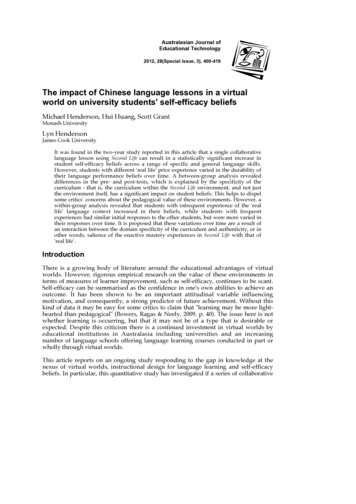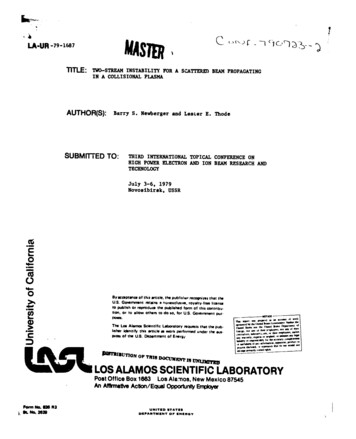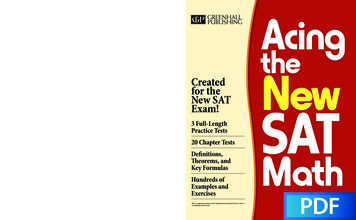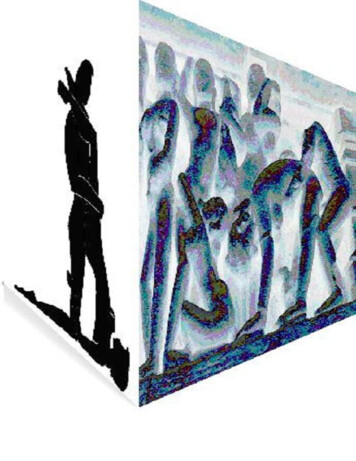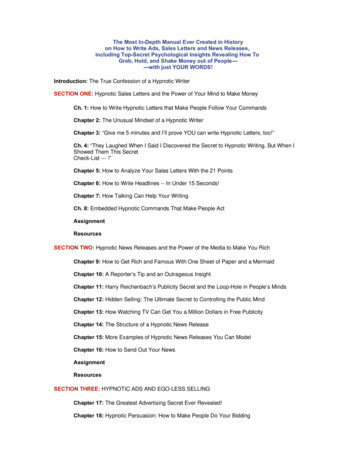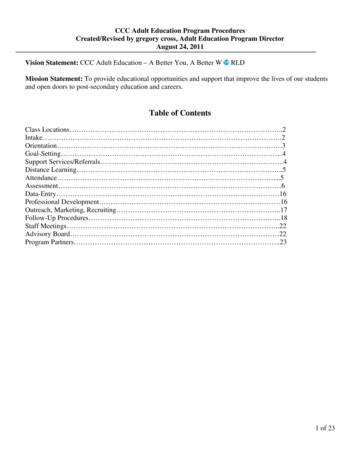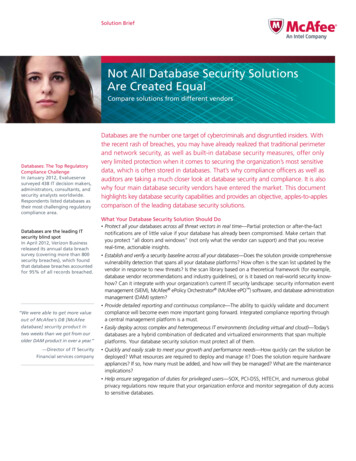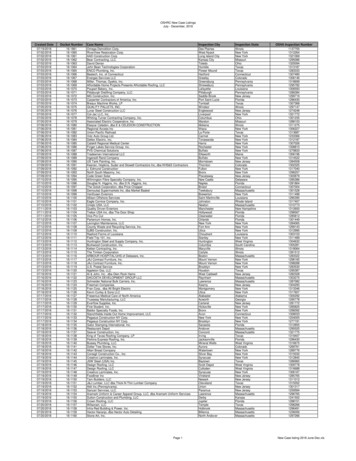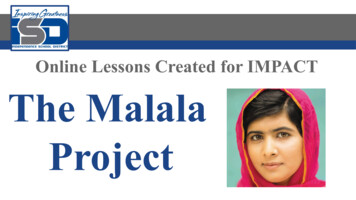
Transcription
Online Lessons Created for IMPACTThe MalalaProject
The Malala ProjectLearning Targets: Empathy for other culturesWhat it means to be a global citizenProject planning and communicationStandards: 5.TS.7.A.a Identify, select, analyze, evaluate, and use resources to create a product of social science inquirywith guidance and support as needed.5.TS.7.G Research and defend a point of view/position on a social studies question.5.R.1.C.b text to world connections5.W.1.B.e Address an appropriate audience, organization, and purpose5.W.1.B.a Choose an appropriate organizational structure and build on one main idea
The Malala ProjectDoesn’t it feel strange that school is not in session right now? Ifind myself missing my students, class discussions and teachinglessons, as well as the people I work with - like Mrs. G!I would be lost without school! I love learning and teaching! Istarted to wonder what it would be like if we didn’t have theright to go to school. Education is so important, and noteveryone in our world has access to it.This week we will be learning about a girl named Malala, and how she stood up for her rightto go to school. We will also be working on a project to inform other students and adultshow important education is to our society!
The Malala ProjectHi, IMPACT Friends!This week we are going to focus on advocacy! Weare going to learn about how Malala spoke out forsomething she deeply believed in and made adifference in so many people’s lives. You too canbe an advocate and teach others about somethingyou strongly believe in. Mrs. B
Who is Malala? Malala attended an all girls school that her father had founded in Pakistan. Then the Taliban (terrorists) tookcontrol and said that girls could no longer go to school. In September 2008, Malala gave a speech titled "How darethe Taliban take away my basic right to education?"In 2009, Malala began blogging for the BBC (British TV) about the Taliban’s threats to deny her an education.Her activism resulted in a nomination for the International Children's Peace Prize in 2011. That same year, she wasawarded Pakistan's National Youth Peace Prize.On October 9, 2012, Taliban gunmen boarded her school bus and shot Malala in the head. Miraculously, shesurvived the attack, and after several surgeries and physical therapy, she was able to start attending school inEngland. The shooting resulted in a massive outpouring of support that continued through her recovery.Just nine months after being shot, she gave a speech at the United Nationsin 2013 on her 16th birthday.In October 2014, Yousafzai became the youngest person to receive theNobel Peace Prize, at just 17 years old; she received the award along with Indianchildren's rights activist Kailash Satyarthi.For her 18th birthday, in July 2015, Yousafzai continued to take action onglobal education by opening a school for Syrian refugee girls in Lebanon. Itsexpenses covered by the Malala Fund, the school was designed to admit nearly200 girls from the ages of 14 to 18.
Resources:BiographyMalala’s StoryNobel Speech VideoHer Nobel Speech (transcript)Who Created the Nobel Prize?Your Mission:Malala has hired you to be a part of her advocacy team! Your job is to educate your community aboutthe importance of school to the families of Independence. You will have several options on how youcan share your information.Advocacy: the public support for particular cause or policy.
Day OneThe Malala ProjectFinding the Facts!Which countries should Malala’sAdvocacy team focus their efforts on?Take a moment and predict which continent will havethe most countries that need to change their support forgirl’s education.
Day OneThe Malala ProjectThe top 10 toughest countries for girls' education:1.2.3.4.5.6.7.8.9.10.South Sudan: the world's newest country has faced much violence and war, withthe destruction of schools and families forced from their homes. Almostthree-quarters of girls do not even make it to elementary schoolCentral African Republic: one teacher for every 80 studentsNiger: only 17% of women between the ages of 15 and 24 are literateAfghanistan: wide gender gap, with boys more likely to be in school than girls (Middle East)Chad: has many social and economic barriers to girls and women getting educationMali: only 38% of girls finish elementary schoolGuinea: the average time in education among women over the age of 25 is lessthan one yearBurkina Faso: only 1% of girls complete high schoolLiberia: almost two-thirds of elementary age girls do not attend schoolEthiopia: two out of five girls are married before the age of 18Note: For some countries, such as Syria, there was insufficient reliable data for them to be included. Stats from BBC.com
Day OneThe Malala ProjectHow do we communicate these facts?The information needs to be: Eye Catching Visually Interesting Easy to Read Not too longHowabout aninfographic?
Day OneThe Malala ProjectWhat’s an Infographic?An infographic is a collection of pictures, charts, and very little text that gives an easy-to-understandoverview of a topic. In the United States, girls have the right to an education, but we are lacking inencouraging girls to look at STEM related classes and jobs. Below are examples of graphics used in a muchlarger infographic. Take a look at these free examples of infographic posters.
Day OneThe Malala ProjectCreate your own Infographic!Mrs. Bonner walks you throughhow to create your own infographicusing the Venngage InfographicMaker website. Be sure to click on full screen.
The Malala ProjectWhat did we learn today?1.2.3.How many students does each teacher have in Central African Republic?In which country does only 38% of girls finish elementary school?In Niger, what percentage of women between the ages of 15 and 24 are literate(can read)?Now that you know about the lack of educationfor girls in our world, let’s take a look at how wecan build a better school in other countries!
Day TwoThe Malala ProjectFinding the Facts!What are the benefits of educating girls ?Take a moment and predict two benefits of educatinggirls that might occur in other countries.
Day TwoThe Malala ProjectBenefits to Educating Girls1.2.3.4.5.6.Each additional school year, can increase a woman’s earning by 20%.The child of a mother who can read, is 50% more likely to live past the age of 5.Educated women have a greater chance of escaping poverty (not having enough money to live).The UN Human Poverty Index ranked the quality of life in 186 countries. Afghanistan ranked 175out of 186 in quality of life. Pakistan ranked 148 out of 186 countries.Educated women “learn what their children need to stay healthy and how find health care, betternutrition and cleaner disposal of wastes. Educated females also channel more of their resources tothe health of their children than men.Promoting women’s empowerment/education reduces poverty.The rights of children are linked to the rights of women. Neither will be realized without endingdiscrimination in all forms, especially gender-based discrimination.
Day TwoThe Malala ProjectHow do we communicate these facts?The information needs to be: Quick Interesting Available to those whocannot readHowabout aPodcast?
Day TwoThe Malala ProjectWhat’s a Podcast?A podcast is a lot like a radio show. It has episodes, like a TV show would have, and it’s usually in audio-only format,although video podcasts do exist. The length of a podcast episode can vary drastically, anywhere from two minutes totwo hours, and they produce on a schedule that ranges from daily to “whenever.” Listeners will typically subscribe tofavorite podcasts, so that new episodes are delivered to them through whatever app they use.You will use the Seesaw app to create a podcast.Click on the green circle with the addition sign.Take a picture of yourself and add a recordingby clicking on the microphone on the left sideof the screen. Remember, your podcast needs tobe 5 minutes or shorter!
Day TwoThe Malala ProjectIf you are interested in listening to some kid friendly podcasts, you can check out the 25 Best Podcastsfor Kids. This website also has podcasts for science fans! The following podcast looks interesting.
The Malala ProjectWhat did we learn today?1.2.Name three ways educating girls helps communities.Explain why it is important for women to learn how to read.Now that you know a few facts about howeducating women helps communities andcountries, let’s learn about one of the solutions.
Day ThreeThe Malala ProjectFinding the Facts!Awareness and advocacy are ways we canhelp support education for girls. Let’s thinkabout another solution that could helpeducate girls!Take a moment and make a list of how you can supporteducation efforts for girls. Did you think of at least 10?
Day ThreeThe Malala ProjectOne Way Malala is HelpingWhen Malala turned 18, she celebrated in a very special way! She started a highschool for Syrian refugee girls in Lebanon.The school will serves more than 200 Syrian girls between ages 14 and 18,according to the Malala Fund, a nonprofit organization, which is helping supportthe school."I am honored to mark my 18th birthday with the brave and inspiring girls of Syria. I am here on behalfof the 28 million children who are kept from the classroom because of armed conflict. Their courage anddedication to continue their schooling in difficult conditions inspires people around the world and it isour duty to stand by them," Malala said. "On this day, I have a message for the leaders of this country,this region and the world — you are failing the Syrian people, especially Syria's children. This is aheartbreaking tragedy — the world's worst refugee crisis in decades." Malala Yousafzai
Day ThreeThe Malala ProjectMalala is not the only one!The Oprah Winfrey Leadership Academy for Girls (OWLAG) — which was opened in 2007 — aims togive girls in South Africa that critical access. Studies show that when girls do not have access toeducation, almost every aspect of a society is negatively impacted.South Africa used to be known for apartheid. That was a system ofsegregation based on race. Before 1994 (when apartheid ended), only 9%of total enrollments in higher education were black students, even thoughthey made up 70% of the population. Now elementary school enrollmentrates are roughly equal: from 2008-2012, the primary school enrollmentrate for boys was 89.7 percent; for girls, it was 90.9 percent.“My hope was that I would give them an opportunity to see the best of themselves reflected through an openmind, an open heart, to what is possible, And I can honestly say I have achieved that.” Oprah Winfrey
Day ThreeThe Malala ProjectHow do we take this idea and make it our own?Your design needs to include: Dorms(with bathrooms/showers) Cafeteria/Kitchen Classrooms/Science Lab Bathrooms Outdoor spaces LibraryLet’s designour ownschool!
Day ThreeThe Malala ProjectWhat can I use to design my school?You can use whatever you have at home! You might try: MinecraftCardboardDraw it on paperLEGOsUse chalk in your drivewayGoogle Sketch UpWhat can you think of?
The Malala ProjectWhat did we learn today?1.2.What are three really important things that you included in your school?Which country would you build your school in, and why?Now that you have designed your own boardingschool for girls, let’s investigate schools in theUnited States. Is education equal for boys andgirls in our own country?
Day FourThe Malala ProjectFinding the Facts!Is education equal here in the UnitedStates? Is there an area that we can improvefor girls?Take a moment and predict which areas of education seelower enrollment rates for girls.
Day FourThe Malala ProjectGirls in the STEM STEM stands for science, technology, engineering and math.Only 15% of engineering faculty in universities and four year colleges are women.Only 11% of teenage girls expressed interest in STEM job fields in 2017.One in four (25%) computer and mathematical workers are women.Less than 30% of the world’s researchers are women.One in ten (10%) scientists or engineers is a minority women.Women in STEM make 33% more money than women in non-STEM fields.Women led tech companies are 35% more profitable.74% of middle school girls who participate in STEM activities say they are likely tostudy computer science in high school.
Day FourThe Malala ProjectThere’s a gender (boy/girl) imbalance that persists in STEM-related fields. The number ofwomen in these jobs generally hovers between 10 and 30 percent, even though havingwomen involved offers so much to the world.If half of the population isn’t contributing to the bestideas, they’re not, in fact, the best ideas.Without female inventors, we wouldn’t have windshield wipers, coffee filters anddisposable diapers. Recent innovations that have come from girls and women include asmartphone attachment that lets parents diagnose ear infections, and a water-purificationsystem that uses an inexpensive photo catalyst and sunlight to produce clean drinking water.
Day FourThe Malala ProjectHow do we communicate these facts?Your information must include: Facts that include numbers Interesting pictures Persuade girls to try STEMactivities, classes and clubs!Let’s designa poster foryour school!
Day FourThe Malala ProjectWhat can I use to create my STEM poster?You can use whatever you have at home! You might try: MarkersCrayonsPaintPictures from magazinesGoogle DocsChalk on the drivewayPictures of yourself or familymembers
The Malala ProjectWhat did we learn today?1. Explain why we need more girls in the STEM fields.2. Can you back that up with a fact or statistic?Malala has been so impressedwith your work! Now she isassigning you to be in charge ofthis year’s advocacy campaign!
Day FiveThe Malala ProjectYour Final Project!Malala has thought of several options foryour advocacy campaign. Decide whichproject you would like to work on toeducate your community.If you would like Mrs. B to see your work, you canemail her or take a picture for Seesaw!
according to the Malala Fund, a nonprofit organization, which is helping support the school. "I am honored to mark my 18th birthday with the brave and inspiring girls of Syria. I am here on behalf of the 28 mill
